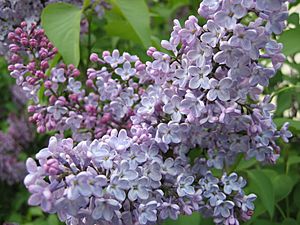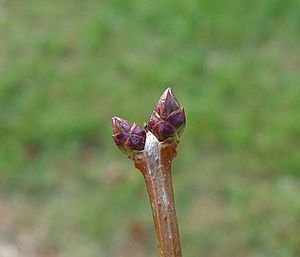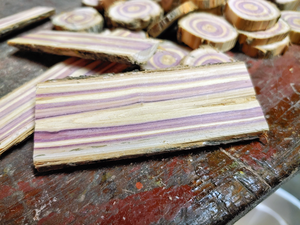Lilac facts for kids
Quick facts for kids Lilac |
|
|---|---|
 |
|
| Syringa vulgaris, common lilac |
|
| Scientific classification |
|
| Kingdom: | Plantae |
| Clade: | Tracheophytes |
| Clade: | Angiosperms |
| Clade: | Eudicots |
| Clade: | Asterids |
| Order: | Lamiales |
| Family: | Oleaceae |
| Tribe: | Oleeae |
| Subtribe: | Ligustrinae |
| Genus: | Syringa L. |
| Synonyms | |
|
|
Lilacs are beautiful flowering plants that belong to the olive family. Their scientific name is Syringa. There are about 12 different kinds of lilacs. These plants originally grew in woodlands and scrub areas from southeastern Europe to eastern Asia. Today, people grow lilacs all over the world in places with mild weather.
Lilacs are closely related to a plant called privet. Some moth caterpillars, like the copper underwing, also enjoy eating lilac leaves.
Contents
What Do Lilacs Look Like?
Lilacs can be small trees or large shrubs. They usually grow between 2 to 10 meters (about 6 to 33 feet) tall. Their stems can be up to 20 to 30 centimeters (about 8 to 12 inches) wide.
The leaves on a lilac plant usually grow in pairs, one across from the other. Most lilac leaves are simple and shaped like a heart or a wide spear. However, a few types of lilacs have leaves that look like feathers.
Lilac Flowers
Lilac flowers bloom in the spring. Each flower is small, about 5 to 10 millimeters (0.2 to 0.4 inches) across. They have four petals and a narrow tube-like base.
Lilac flowers are usually a shade of purple, which is where the color "lilac" gets its name! But you can also find lilacs with white, pale yellow, pink, or even dark red flowers.
The flowers grow in large bunches called panicles. Many types of lilacs have a wonderful, strong smell. Lilacs can bloom from mid-spring to early summer, depending on the specific type. There's even a special kind called 'Bloomerang' that blooms in spring and then again in late summer and fall!
Lilac Fruit and Seeds
After the flowers fade, the plant produces a dry, brown capsule. This capsule is the fruit of the lilac. When it's ready, it splits open to release two winged seeds.
Where Did the Name "Lilac" Come From?
The English name "lilac" comes from the French word lilac. This word can be traced back to Persian words that mean "bluish" or "indigo plant." This makes sense because many lilac flowers are a beautiful blue-purple color!
How Lilacs Got Their Scientific Name
The scientific name for the lilac plant, Syringa, was first officially described in 1753 by a famous scientist named Carl Linnaeus. The name Syringa comes from an ancient Greek word that means "pipe" or "tube." This refers to the hollow branches of the common lilac plant.
Growing Lilacs and Their Uses
Lilacs are very popular shrubs in parks and gardens in areas with mild climates. Many different types and cultivars (special varieties grown by people) have been created. Sometimes, you might hear the term "French lilac." This often refers to modern lilacs that have "double flowers," meaning they have extra petals. A famous plant breeder named Victor Lemoine helped create many of these.
Lilacs grow best in soil that drains well, especially soil that contains chalk. They produce flowers on older branches. If you don't prune them, they will make more flowers. If you cut them back too much, the plant might grow lots of new branches but fewer flowers. Lilac bushes can sometimes get a plant disease called powdery mildew.
Lilac wood is not often used for building or crafts because the trees are usually small. However, it is a very hard wood. It's known to be good for woodturning, which is shaping wood on a spinning machine. The outer part of the wood (sapwood) is usually cream-colored. The inner part (heartwood) can have streaks of brown and purple.
People in Asia have historically used parts of lilac plants in traditional medicines. They used them to treat things like coughs, diarrhea, and bronchitis. Scientists have found special compounds in lilacs that may have effects like fighting tumors, lowering blood pressure, reducing swelling, and acting as antioxidants.
What Lilacs Symbolize
Lilacs are often seen as a symbol of first love.
In countries like Greece, Macedonia, Lebanon, and Cyprus, lilacs are strongly connected to Easter. This is because they bloom around that time of year. Because of this, they are sometimes called paschalia.
In the famous poem When Lilacs Last in the Dooryard Bloom'd by Walt Whitman, lilacs are used to represent Abraham Lincoln.
The common lilac (Syringa vulgaris) is the state flower of New Hampshire. It was chosen because it represents the strong character of the people who live there.
Lilac Festivals Around the World

Many places in North America hold yearly Lilac Festivals to celebrate these beautiful flowers:
- The Arnold Arboretum in Boston, Massachusetts, has a "Lilac Sunday" every May. They have over 422 lilac plants of 194 different kinds. This is the only day of the year when people can have picnics on the grounds.
- Lombard, Illinois, is known as the "Lilac Village." They have an annual lilac festival and parade in May. The village also has Lilacia Park, a garden with over 200 types of lilacs and many kinds of tulips.
- Mackinac Island, in Michigan, celebrates a week-long lilac festival and parade every June.
- Rochester, New York, has held its Lilac Festival since 1898. It is the longest-running lilac festival in North America. Held in Highland Park, this festival features 1,200 lilac bushes, representing over 500 different types. It's the largest collection of lilac varieties in one place!
- The Royal Botanical Gardens near Hamilton, Ontario, in Canada, holds its Lilac Celebration every May.
- Spokane, Washington, is called the "Lilac City." They have an annual lilac festival and parade.
- Franktown, Ontario, Canada, is known as the Lilac Capital of Canada. They hold an annual festival with demonstrations and horse-pulled wagon rides.
- Calgary, Alberta, Canada, holds a one-day Lilac Festival, which is mostly a street festival.
Types of Lilacs
Here are some of the different types of lilacs:
- Syringa emodi – Himalayan lilac, found in northern India, Pakistan, Tibet, and Nepal.
- Syringa josikaea – Hungarian lilac, found in the Carpathian Mountains of Romania and Ukraine.
- Syringa komarowii – nodding lilac, found in parts of China.
- Syringa oblata – early blooming lilac or broadleaf lilac, found in Korea and many parts of China.
- Syringa oblata subsp. dilatata – Korean early lilac, found in Korea and parts of China.
- Syringa pinetorum – found in Sichuan, Tibet, and Yunnan (China).
- Syringa pinnatifolia – found in parts of China.
- Syringa pubescens – found in Korea and many parts of China.
- Syringa reticulata – Japanese tree lilac, found in Japan, Korea, and many parts of China.
- Syringa tomentella – found in Sichuan, Tibet, and Yunnan (China).
- Syringa villosa – villous lilac, found in Korea and parts of China.
- Syringa vulgaris – common lilac, originally from the Balkans, but now grows wild in many places in Europe and North America.
Hybrid Lilacs
Scientists and gardeners have also created new types of lilacs by crossing different species. These are called hybrids:
- S. × chinensis (a mix of S. vulgaris and S. persica)
- S. × diversifolia (a mix of S. oblata and S. pinnatifolia)
- S. × henryi (a mix of S. josikaea and S. villosa)
- S. × hyacinthiflora (a mix of S. oblata and S. vulgaris)
- S. × josiflexa (a mix of S. josikaea and S. komarowii)
- S. × laciniata – cut-leaf lilac (a mix of S. protolaciniata and S. vulgaris)
- S. × persica – Persian lilac, found in Afghanistan, Pakistan, and parts of China.
- S. × prestoniae (a mix of S. komarowii and S. villosa)
- S. × swegiflexa (a mix of S. komarowii and S. sweginzowii)
Related Pages
- Syringa vulgaris – This page tells you more about the common lilac.
Images for kids
-
Lilacs, by Vincent van Gogh, 1889
See also
 In Spanish: Lilas para niños
In Spanish: Lilas para niños



























